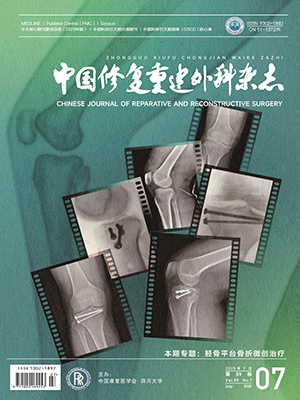| 1. |
Shang F, Yu Y, Liu S, et al. Advancing application of mesenchymal stem cell-based bone tissue regeneration. Bioact Mater, 2020, 6(3): 666-683.
|
| 2. |
Wu R, Li Y, Shen M, et al. Bone tissue regeneration: The role of finely tuned pore architecture of bioactive scaffolds before clinical translation. Bioact Mater, 2020, 6(5): 1242-1254.
|
| 3. |
Fan X, Teng Y, Ye Z, et al. The effect of gap junction-mediated transfer of miR-200b on osteogenesis and angiogenesis in a co-culture of MSCs and HUVECs. J Cell Sci, 2018, 131(13): jcs216135. doi: 10.1242/jcs.216135.
|
| 4. |
Chai M, Gu C, Shen Q, et al. Hypoxia alleviates dexamethasone-induced inhibition of angiogenesis in cocultures of HUVECs and rBMSCs via HIF-1α. Stem Cell Res Ther, 2020, 11(1): 343. doi: 10.1186/s13287-020-01853-x.
|
| 5. |
Shen Q, Fan X, Jiang M, et al. Inhibiting expression of Cxcl9 promotes angiogenesis in MSCs-HUVECs co-culture. Arch Biochem Biophys, 2019, 675: 108108. doi: 10.1016/j.abb.2019.108108.
|
| 6. |
Hoch AI, Binder BY, Genetos DC, et al. Differentiation-dependent secretion of proangiogenic factors by mesenchymal stem cells. PLoS One, 2012, 7(4): e35579. doi: 10.1371/journal.pone.0035579.
|
| 7. |
Chen M, Wang X, Ye Z, et al. A modular approach to the engineering of a centimeter-sized bone tissue construct with human amniotic mesenchymal stem cells-laden microcarriers. Biomaterials, 2011, 32(30): 7532-7542.
|
| 8. |
Costa-Almeida R, Soares R, Granja PL. Fibroblasts as maestros orchestrating tissue regeneration. J Tissue Eng Regen Med, 2018, 12(1): 240-251.
|
| 9. |
Shah S, Kang KT. Two-cell spheroid angiogenesis assay system using both endothelial colony forming cells and mesenchymal stem cells. Biomol Ther (Seoul), 2018, 26(5): 474-480.
|
| 10. |
Gagnon E, Cattaruzzi P, Griffith M, et al. Human vascular endothelial cells with extended life spans: in vitro cell response, protein expression, and angiogenesis. Angiogenesis, 2002, 5(1-2): 21-33.
|
| 11. |
Lee E, Takahashi H, Pauty J, et al. A 3D in vitro pericyte-supported microvessel model: visualisation and quantitative characterisation of multistep angiogenesis. J Mater Chem B, 2018, 6(7): 1085-1094.
|
| 12. |
Feng XD, Marcia GT, Shaker AM, et al. Fibrin and collagen differentially but synergistically regulate sprout angiogenesis of human dermal microvascular endothelial cells in 3-dimensional matrix. Int J Cell Biol, 2013, 231279. doi: 10.1155/2013/231279.
|
| 13. |
Parenteau NL, Bilbo P, Nolte CJ, et al. The organotypic culture of human skin keratinocytes and fibroblasts to achieve form and function. Cytotechnology, 1992, 9(1-3): 163-171.
|
| 14. |
Rioja AY, Tiruvannamalai Annamalai R, Paris S, et al. Endothelial sprouting and network formation in collagen- and fibrin-based modular microbeads. Acta Biomater, 2016, 29: 33-41.
|
| 15. |
Rademakers T, Horvath JM, van Blitterswijk CA, et al. Oxygen and nutrient delivery in tissue engineering: Approaches to graft vascularization. J Tissue Eng Regen Med, 2019, 13(10): 1815-1829.
|
| 16. |
Correia CR, Bjørge IM, Zeng J, et al. Liquefied microcapsules as dual-microcarriers for 3D+3D bottom-up tissue engineering. Adv Healthc Mater, 2019, 8(22): e1901221. doi: 10.1002/adhm.201901221.
|
| 17. |
Nguyen BB, Moriarty RA, Kamalitdinov T, et al. Collagen hydrogel scaffold promotes mesenchymal stem cell and endothelial cell coculture for bone tissue engineering. J Biomed Mater Res A, 2017, 105(4): 1123-1131.
|
| 18. |
Tocchio A, Tamplenizza M, Martello F, et al. Versatile fabrication of vascularizable scaffolds for large tissue engineering in bioreactor. Biomaterials, 2015, 45: 124-131.
|
| 19. |
Landau S, Ben-Shaul S, Levenberg S. Oscillatory strain promotes vessel stabilization and alignment through fibroblast YAP-mediated mechanosensitivity. Adv Sci (Weinh), 2018, 5(9): 1800506. doi: 10.1002/advs.201800506.
|
| 20. |
Roux BM, Akar B, Zhou W, et al. Preformed vascular networks survive and enhance vascularization in critical sized cranial defects. Tissue Eng Part A, 2018, 24(21-22): 1603-1615.
|
| 21. |
Stenzel D, Lundkvist A, Sauvaget D, et al. Integrin-dependent and -independent functions of astrocytic fibronectin in retinal angiogenesis. Development, 2011, 138(20): 4451-4463.
|
| 22. |
Wong SP, Rowley JE, Redpath AN, et al. Pericytes, mesenchymal stem cells and their contributions to tissue repair. Pharmacol Ther, 2015, 151: 107-120.
|
| 23. |
Potente M, Mäkinen T. Vascular heterogeneity and specialization in development and disease. Nat Rev Mol Cell Biol, 2017, 18(8): 477-494.
|
| 24. |
Stoffels JM, Zhao C, Baron W. Fibronectin in tissue regeneration: timely disassembly of the scaffold is necessary to complete the build. Cell Mol Life Sci, 2013, 70(22): 4243-4253.
|
| 25. |
Shafiee S, Shariatzadeh S, Zafari A, et al. Recent advances on cell-based co-culture strategies for prevascularization in tissue engineering. Front Bioeng Biotechnol, 2021, 9: 745314. doi: 10.3389/fbioe.2021.745314.
|
| 26. |
Marchand M, Monnot C, Muller L, et al. Extracellular matrix scaffolding in angiogenesis and capillary homeostasis. Semin Cell Dev Biol, 2019, 89: 147-156.
|




